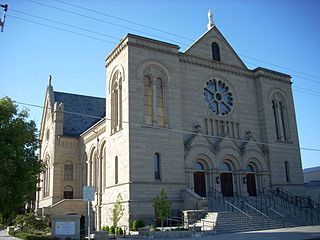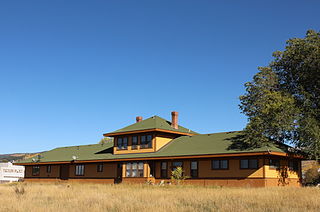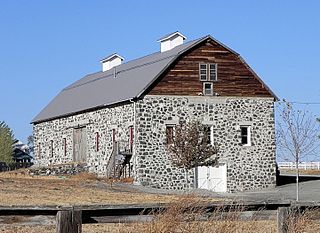
The Idaho State Capitol in Boise is the home of the government of the U.S. state of Idaho. Although Lewiston briefly served as Idaho's capital from the formation of Idaho Territory in 1863, the territorial legislature moved it to Boise on December 24, 1864.

The Mason Cornwall House is located in Northern Idaho at 308 South Hayes Street in Moscow, Idaho. The residence is a Victorian Italianate style house constructed of brick with a stucco finish. It is architecturally significant as one of the finest houses of its period in this area. The Cornwall house is listed on the National Register of Historic Places. It is currently used as a private dwelling.

The Main Building of Vassar College is the oldest surviving building on its campus in Poughkeepsie, New York, and the center of academic life. It was built by James Renwick, Jr. in the Second Empire style in 1861, the second building in the history of what was one of America's first women's colleges. It is one of the earliest, largest, and most important examples of Second Empire architecture in the United States and is a National Historic Landmark for its architecture and educational significance. At the time of its completion, the structure contained the most interior space of any building in the United States, and housed the entire college, including dormitories, libraries, classrooms, and dining halls. Currently, the first and second floors house campus administration while the remaining three house student rooms.

Herbert and Katherine Jacobs First House, commonly referred to as Jacobs I, is a single family home located at 441 Toepfer Avenue in Madison, Wisconsin, United States. Designed by noted American architect Frank Lloyd Wright, it was constructed in 1937 and is considered by most to be the first Usonian home. It was designated a National Historic Landmark in 2003. The house and seven other properties by Wright were inscribed on the World Heritage List under the title "The 20th-Century Architecture of Frank Lloyd Wright" in July 2019.

Herbert and Katherine Jacobs Second House is a historic house located at 3995 Shawn Trail in Madison, Wisconsin, United States. Built in 1946-48, the house was the second of two designed by Frank Lloyd Wright for journalist Herbert Jacobs and his wife Katherine. The house's design is unique among Wright's works; he called the style the "Solar Hemicycle" due to its semicircular layout and use of natural materials to conserve solar energy. The house was added to the National Register of Historic Places in 1974 and declared a National Historic Landmark in 2003.

The Failing Office Building is a building in downtown Portland, Oregon, United States that was listed on the National Register of Historic Places on October 31, 2007. The building was built during the rapid growth in Portland's business district after the Lewis and Clark Centennial Exposition in 1905. It was built with six stories in 1907, with a six-story addition in 1913. It features a reinforced steel-frame structure with facades of yellow brick and glazed terra cotta.

Bristol County Jail is a historic jail at 48 Court Street in Bristol, Rhode Island and home to the Bristol Historical and Preservation Society.

The Salmon Odd Fellows Hall is a historic building located at 510-514 Main St. in Salmon, Idaho. The Salmon chapter of the International Order of Odd Fellows built the hall in 1907 to replace their previous building, the 1874 Odd Fellows Hall. The Classical Revival building was designed by local architect Allan Merritt. The building features three bays separated by pilasters on its first floor and terra cotta moldings above and below the second floor windows. The second floor also includes an oval stained glass window and two small windows topped by keystones.

The Delaware County Courthouse, located in Manchester, Iowa, United States, was built in 1894. It was listed on the National Register of Historic Places in 1981 as a part of the County Courthouses in Iowa Thematic Resource. The current structure is the fourth building to house court functions and county administration.

The Bagby Stationhouse, Water Tanks and Turntable are associated with the Yosemite Valley Railroad (YVRR), which ran from Merced, California to El Portal at the entrance to Yosemite National Park. The railroad operated from 1907 to 1945.

Woodburn Circle, also known as W.V.U. Quadrangle, is part of the downtown campus of West Virginia University; it's located at Morgantown, Monongalia County, West Virginia. The circle, in reality a quadrangle grouped around an oval path, is a historic and distinctive architectural assembly of three collegiate buildings, which evolved in the late nineteenth century. In chronological order these are Martin Hall, Woodburn Hall and Chitwood Hall. However, it's the largest of the buildings, Woodburn Hall, that is best known and a symbol of the university.

The Cathedral of St. John the Evangelist, also known simply as St. John's Cathedral, is a Catholic cathedral and parish church located in Boise, Idaho, United States. It is the seat of the Diocese of Boise. The church building was individually listed on the National Register of Historic Places in 1978. It was included as a contributing property of the St. John's Cathedral Block when the rest of the parish buildings on Block 90 were added to the National Register in 1982. That same year, the parish buildings were included as a contributing property in the Fort Street Historic District.

The First Bank of Vale is a historic building located in Vale, Oregon. It was built in 1901 from completely from locally quarried native stone by local pioneers, the Hope brothers. The compact two story building is vernacular architecture of the Richardson Romanesque style. It was listed on the National Register of Historic Places on 5 March 1992.

The Empire School, located in rural Minidoka County, Idaho about 3 miles (4.8 km) south of Rupert, was listed on the National Register of Historic Places in 2001.

The Victor Railroad Depot is a two-story building located in Victor, Idaho which was listed on the National Register of Historic Places in 1995.

The Jay Van Hook Potato Cellar is a historic potato house located in Jerome, Idaho.

The Arnold Stevens House is a historic house located in Jerome, Idaho. It is part of the Lava Rock Structures in South Central Idaho Thematic Resource and was listed on the National Register of Historic Places on September 8, 1983.

The Greer and Jennie Quay House is a historic house located in Jerome, Idaho.

The Jacob B. Van Wagener Barn is lava rock structure built in 1912. It located in Jerome, Idaho, United States, and was listed on the National Register of Historic Places in 1983.

The A. O. Huntley Barn, in Adams County, Idaho near Cuprum, Idaho, was built in 1902. It was listed on the National Register of Historic Places in 1978.





















